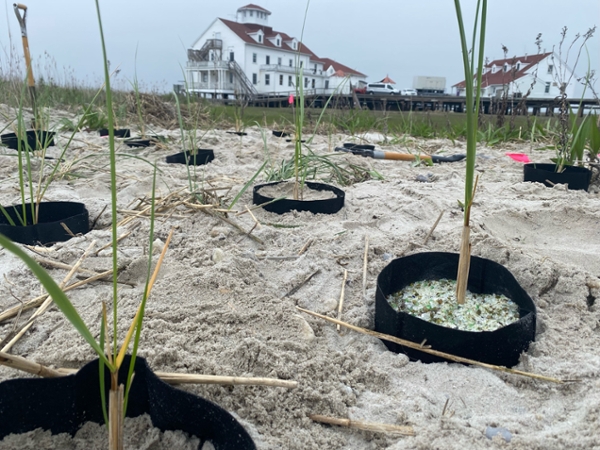Rowan researchers probe uses for recycled glass – from dune replenishment to planting medium
Rowan researchers probe uses for recycled glass – from dune replenishment to planting medium

Kaleidoscopic and beautiful, fragments of glass glittered among grains of sand filling planters of dune grass in a Rowan University research project this summer.
The hope: that vast quantities of brown, blue, white, gold and green fragments, their sharp edges tumbled smooth and mixed in varying concentrations with beach sand, would offer renewed promise for recycling bottles and jars.
Pooling resources, skills and expertise in a cross-campus initiative, Rowan researchers see the challenge of glass recycling as an opportunity to reuse more of the material and, potentially, bolster the ever-present Jersey shore need for dune replenishment. The initiative includes faculty from the Henry M. Rowan College of Engineering; the School of Earth & Environment; the Ric Edelman College of Communication & Creative Arts; and the William G. Rohrer College of Business.
Growing grass in glass
School of Earth & Environment faculty Charles Schutte, Ph.D., and Lily Pfeifer-Johnson, Ph.D., deployed about a ton of crushed glass material in a series of experiments this summer to determine if Jersey shore dune grass would grow in it.
If it would, they theorized, the crushed glass, which derives from sand, might one day serve in dune replenishment projects, easing the need for costly mined or dredged sand and making good use of countless tons of bottles and jars collected annually for recycling.
“We need to think about how sand is a finite resource,” said Pfeifer-Johnson, a sedimentologist in the Department of Geology. “We either dredge it, which is not efficient, or we mine it.”
In addition to beach replenishment, sand is widely used in construction, especially for concrete.
“Our idea was there is something about this material that can supplement beach sand and that plants can grow in,” Pfeifer-Johnson said.
Unfortunately, Schutte said, dune grass near the shore did not grow well in high concentrations of untreated crushed glass, possibly because microbes on the material consumed as much as 10 times more oxygen than plain sand would, robbing young plants of access to it.
“In a 10 percent glass mix the plants did grow, but in pure glass they did not,” said Schutte, a biogeochemist in the Department of Environmental Science.
Schutte and Pfeifer-Johnson, who stressed that there are no current plans to supplement New Jersey dunes with crushed glass, conducted their experiment at the Rutgers University Marine Field Station in Tuckerton. There, they said, greater salinity in the air and sand seemed to have caused a chemical reaction in higher concentrations of untreated glass that killed the dune grass plants.
On the other hand, they noted, plants grown in various concentrations of crushed glass on the Glassboro campus thrived.
“In pure form, the glass won’t work as a growing medium (in sand dunes) but as a supplement it could,” Schutte said.
Though glass is up to 100 percent recyclable, the Glass Packaging Institute, a trade association for the North American glass container industry, reported in 2018 that less than 30 percent of glass collected in the U.S. is actually recycled.
Engineering solutions for recycled glass
Without question, recycling presents an opportunity for better solutions, said Joe Stanzione, Ph.D., a professor in the College of Engineering and director of the Advanced Materials & Manufacturing Institute (AMMI).
Stanzione and a small team of junior and senior engineering students are pursuing new methods for reusing glass collected from across campus. In their “Re-Glassing Glassboro” clinic project, the students worked with departments across the University to set up a small glass collection and processing facility on the West Campus.
Through a collaboration with Bottle Underground, a Philadelphia-based nonprofit, the students are pursuing new manufacturing and applications for crushed glass. Research is ongoing, but the team’s efforts have generated fresh ideas and projects for finding new ways to use old glass.
It’s a worthwhile endeavor, noted Stanzione, whose research on sustainable materials has received substantial support from the Department of Defense and the National Science Foundation.
“Advancing our circular economy through the strategic and engineered use and reuse of an historic product to South Jersey is at the heart of our ‘glass roots’ educational experience for our students,” said Stanzione. “It is an education and means of sustainably living that they can adopt now and can continue to utilize and expand, both personally in their communities and in their careers.”